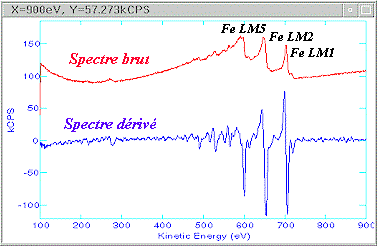 |

When the material undergoes an electron beam bombardment, emitted electrons are collected by a lens then directed toward the analyser.
The gun is usually set at an acceleration voltage around 10 kvolts, and the collected current is around 1 microampere. The smaller is the collected current, the better is the resolution. In return the measured signal decreases with the collected current. Here is an example of AES spectra which we can obtain. We already mentioned on the preceding page that the first order derivative is often used to highlight the peaks.  To get a spectrum, it is sometimes necessary to clean (etch) the surface of the specimen. Indeed, this type of spectrometry concerns the very first atomic layers at the surface of the specimen; therefore any contamination, e.g. due to air exposure, is sufficient to interfere with the signal. The stability of the collected current is absolutely required. After starting the electron gun and before getting the first spectrum more than one hour can elapse because several steps must be iterated until a perfect stability is achieved. When these conditions are established, the current collected from the specimen is adusted at a few microamperes. The goal is to have an electron amplifier to generate a secondary image. The analysis points are then easily found. For insulating specimens, it is often impossible obtain an image or even an analysis. XPS can then be a replacement solution. |